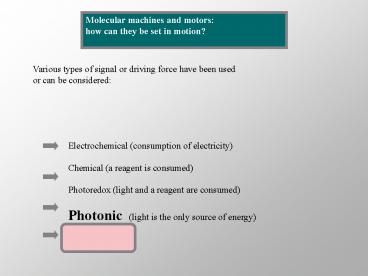Pr PowerPoint PPT Presentation
Title: Pr
1
Molecular machines and motors how can they be
set in motion?
Various types of signal or driving force have
been used or can be considered
Electrochemical (consumption of
electricity) Chemical (a reagent is
consumed) Photoredox (light and a reagent are
consumed) Photonic (light is the only source
of energy)
2
1MLCT excited state
the Ru(bipy)32 family
3d-d state
3MLCT
dissociative state
from the 3MLCT excited state, the strongly
antibonding 3d-d state can be populated
thermally, depending on the ligand field. This
process may be followed by ligand expulsion
ground state
3
(No Transcript)
4
photochemical expulsion of a Ru(phen)2 fragment
from a ring
yellow
red complex
the photochemical process and the thermal
reaction are both quantitative
5
Can one inscribe a Ru(phen)2 fragment in a rod
(axial fragment) or in a ring, in order to make a
rotaxane or a catenane?
6
A bis-bipy ligand leading exclusively to a C2
arrangement Alex von Zelewsky et al. (Fribourg)
one of the "CHIRAGENS"
7
resolution Jérôme Lacour and coworkers
8
(No Transcript)
9
Ruthenium Complex
10
towards rotaxanes whose axis incorporates a
Ru(phen)2 fragment
11
the threading step
12
structure of the ruthenium(II) pseudo- rotaxane
13
the real rotaxane could be prepared by classical
stoppering it is photochemically active
preliminary results
14
under light irradiation, the ring is
decoordinated from the ruthenium centre
thermally, it is recoordinated
preliminary results
15
a 2catenane constructed around a Ru(diimine)32
complex used as a template
16
a 2catenane constructed around a Ru(diimine)32
complex used as a template
towards light-driven molecular machines
17
1MLCT excited state
the Ru(bipy)32 family
3d-d state
3MLCT
dissociative state
from the 3MLCT excited state, the strongly
antibonding 3d-d state can be populated
thermally, depending on the ligand field. This
process may be followed by ligand expulsion
ground state
18
(No Transcript)
19
synthesis strategy
20
coordination of Ru(II) to the macrocyclic ligand
2
(21)
M Ru(II) L CH3CN
21
chiral complex (C2 symmetry)
22
(No Transcript)
23
the threading step
(i)
(56)
(i) 140 in HOCH2CH2OH
24
the ring-closing metathesis reaction leading to
the catenane
Ru
(68)
25
(No Transcript)
26
two different catenanes have been prepared 1 is
the "small" member of the family and 2 is the
"large" one
In both compouds, the bipy-incorporating ring is
a 42-membered ring
27
light-driven molecular motions photochemical
decoordination of the 42-membered ring
the recomplexation reaction is performed
thermally (a few minutes at 140C or two hours at
80C in ethylene glycol)
both processes are quantitative
28
photochemical decomplexation and thermal
recoordination of the bipy-containing ring in the
"large" catenane (42- and 63-membered
interlocking rings)
2
2'
photochemically, the large catenane is much more
reactive than the small one
29
absorption spectra (visible region) of a CH2Cl2
solution containing 2 ("large" catenane) and
NEt4Cl-, before, during and after irradiation
t 0 s (1), 20 s (2), 40 s (3), 60 s (4), 80 s
(5), 110 s (6), 150 s (7), 310 s (8).
30
light-driven molecular motions
h?
31
(No Transcript)
32
Photochemical and thermal ligand exchange in a
ruthenium (II) complex based on a scorpionate
terpyridine ligand Emma R. Schofield, Jean-Paul
Collin
33
synthesis of the ligand (i) LDA, dmtpy,
Br(CH2CH2O)2THP, thf (ii) HCl(aq) (iii) NEt3,
MsCl, DCM, (iv) LiBr, acetone (v) NaH,
4-hydroxybenzonitrile, dmf.
34
12
35
(No Transcript)
36
12
37
1H NMR spectra (400 MHz) of 1PF62 in
pyridine-d5 (9.0-10.5 ppm range) under light
irradiation a t 0, b t 1, c t 2,
d t 3.5, e t 6.5, f t 12.5, g
t 25 mins. Hp2 appears as a doublet at 10.36
ppm in 12 whereas it is strongly shifted
upfield in Ru(tpy)(phen)(py)2, as a result of
substitution of the nitrile ligand by pyridine (?
9.40 ppm)
38
X-ray structures
André De CianNathalie Gruber-Kyritsakas Richard
Welter
39
(No Transcript)

